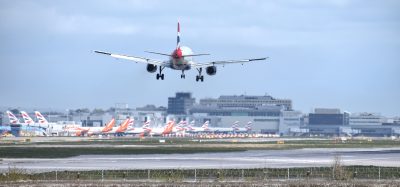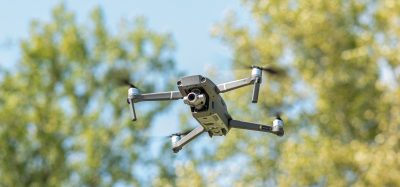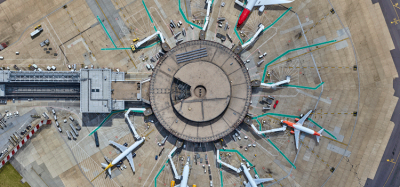The birdstrike risk
- Like
- Digg
- Del
- Tumblr
- VKontakte
- Buffer
- Love This
- Odnoklassniki
- Meneame
- Blogger
- Amazon
- Yahoo Mail
- Gmail
- AOL
- Newsvine
- HackerNews
- Evernote
- MySpace
- Mail.ru
- Viadeo
- Line
- Comments
- Yummly
- SMS
- Viber
- Telegram
- Subscribe
- Skype
- Facebook Messenger
- Kakao
- LiveJournal
- Yammer
- Edgar
- Fintel
- Mix
- Instapaper
- Copy Link
Posted: 16 July 2009 | Ray Elgy, Head of Aerodrome Standards, UK CAA | 1 comment
From the beginning of aviation history, aircraft have faced the hazard posed by birdstrikes. The first known birdstrike occurred in 19051, from the Wright Brothers diaries, “Orville … flew 4,751 metres in 4 minutes 45 seconds, four complete circles. Twice passed over fence into Beard’s cornfield. Chased flock of birds for two rounds and killed one which fell on top of the upper surface and after a time fell off when swinging a sharp curve.” This was the first reported bird-aircraft strike.
From the beginning of aviation history, aircraft have faced the hazard posed by birdstrikes. The first known birdstrike occurred in 19051, from the Wright Brothers diaries, “Orville … flew 4,751 metres in 4 minutes 45 seconds, four complete circles. Twice passed over fence into Beard’s cornfield. Chased flock of birds for two rounds and killed one which fell on top of the upper surface and after a time fell off when swinging a sharp curve.” This was the first reported bird-aircraft strike.
The first known fatality as a direct result of an aircraft-bird collision is said to be in 1912, when Calbraith Rodgers’ piloting a ‘Wright Pusher’ struck a gull, causing the aircraft to crash into the surf at Long Beach, California. The pilot was pinned under the wreckage and subsequently drowned.
The birdstrike hazard has become more severe as aircraft speed has increased, and this is because, although birds are relatively small in comparison to modern aircraft, the impact energy in collisions increases with the square of the relative impact speed.
The effects of birdstrikes on airframes and aircraft engines can be significant. The risk posed by birdstrikes by large single and flocking birds is currently under scrutiny by the US National Transportation Safety Board, as they investigate the serious birdstrike occurrence to US Airways Flight 1549, involving a multiple birdstrike by a flock of migratory Canada Geese (Branta Canadensis) on climb out from New York’s LaGuardia airport on 15 January 2009.
The birdstrike risk posed by large flocking birds, such as Canada Geese, needs constantly to be kept under review, particularly in view of the known growing bird populations (increasing by 8% per annum in the UK2) and changing migration patterns, in turn prompted by other factors including wetland restoration programmes – particularly in North America, and global climate change. Consequently birdstrikes by these species continue to be an area of safety concern for the UK CAA and other National Aviation Administration and Regulatory Authorities around the world.
Mitigation of the birdstrike risk requires combined and concerted action by airports, airlines, landowners, local authorities and land-use planners, conservation bodies and government agencies.
The CAA sets out its guidance with regard to Birdstrikes in CAP 772 Birdstrike Risk Management for Aerodromes. In December 2003 the UK Air Navigation Order (ANO) was amended to make the reporting of all birdstrikes (confirmed, suspected or otherwise) mandatory, regardless of whether damage was caused to the aircraft, or whether the strike event had any effect on the flight. The mandatory reporting requirement was introduced primarily to gather more information on birdstrikes, so that more data could be derived and new strategies could be developed in order to address trends in an attempt to focus on and reduce the incident rate and to address the perceived under-reporting of birdstrike events.
During 2008, 1477 confirmed3 birdstrike occurrences were reported to the CAA, an increase of 40% on the number of strikes reported to the CAA in 2003 (the year immediately prior to mandatory reporting). In the post-mandatory reporting period 2004-2008, the number of strikes reported annually to the CAA has averaged 1537, representing an increase of some 50% compared to the pre-mandatory reporting period.
Most birdstrikes to aircraft result in no damage and are assessed as non-hazardous. However, serious birdstrikes can lead to an aircraft having to abort its take-off, return to the airport it departed from, or to divert to make an emergency landing, and these are notified to the CAA as a Mandatory Occurrence Report (MOR). During 2008 approximately 66 serious birdstrike occurrences to aircraft in the UK were reported to the CAA as an MOR, having either caused damage to the aircraft, forced the crew to take avoiding action, or to divert to alternate aerodromes. This number has been relatively constant year-on-year for the past 10 years, with an average of 58 events annually.
Aero-engine design
The CAA has played a leading role in developing enhanced engine certification requirements, and safety recommendations from the NTSB and AAIB have served further to emphasise the need for such activity. This work has been conducted in co-operation with other safety regulators (the US Federal Aviation Administration, Transport Canada and other European NAAs) and the aero engine industry. In recognition of the capability of modern material technology, large turbo-fan aero-engines are now required to resist multiple birdstrikes from birds of up to 5.5lbs in weight and still produce useful thrust. However, Canada Geese, which fly in skeins and therefore pose the risk of a multiple strike, can weigh up to 8lbs. It is therefore essential that effective management of the large flocking bird population be employed, to complement the benefits of the latest engine birdstrike certification requirements. The certification requirements are only the last line of defence; it is far better to reduce the chances of birdstrikes happening in the first place.
Aerodrome bird control
Bird dispersal and control measures practised by aerodrome operators within the aerodrome boundary remains the main and most effective tool in an airport’s armoury. This requires trained and competent bird control personnel, vigilance and a high degree of intelligence gathering to know what species are habituating the airport and its surrounds and why (habitat), and a determination of which mitigations would be most effective in controlling the species, particularly for those birds within the high-risk species group.
UK licensed airports have developed, together with the CAA, a series of programmes aimed at reducing the risk posed by birds within the airfield boundary. Initiatives such as the development and implementation of a Bird Control Management Plan, as part of the aerodrome Safety Management System (SMS) approach including use of a risk assessment methodology, is now widely adopted as best-practice and advocated in peer guidance material from the International Birdstrike Committee.4
Although birdstrike reporting levels in the UK have increased, it is of concern that a large degree of reports contain “unknown” information, such as the bird species involved. It is widely agreed by stakeholders that an accurate species ID can greatly assist the reliability of risk assessment work carried out by both aerodrome and airline operators (see Figure 1).


Figure 1: UK Birdstrikes by species 2008
As the mitigation measure will vary dependant upon species, it is vital that an accurate identification of species involved in birdstrikes is realised. In the UK, the Bird Management Unit of the Food and Environment Research Agency (FERA) currently conducts a bird remains identification service on behalf of various stakeholders, in a similar manner as is carried out by the Smithsonian Institute in the US. Bird remains identification can be carried out by a number of methods, such as use of digital photography, feather analysis and full DNA profiling.
In an attempt to improve the quality of data being reported to the CAA and increase the percentage of bird identifications, an education and awareness campaign is currently being considered by CAA with the assistance of other stakeholders, such as the Airport Operators Association and UK Flight Safety Committee.
Off-airport bird control
It is now widely recognised by industry experts that the biggest risks from birds, lies in habitat attractants, unchecked bird populations and migratory routes and patterns for birds in the immediate vicinity5 of an airport. Although much work has been done in recent years to focus on increasing the effectiveness of off-airport bird awareness, this is still an area of particular concern to the CAA and stakeholders and is an issue that requires the co-operation of many interested parties and stakeholders. Although within the airport boundary the bird population and risk management and mitigation of birds is generally well established, knowledge and control of bird populations outside the airport boundary are less effective. Consequently, the CAA, industry stakeholders, government, wildlife and conservation groups, all agree that more work needs to be done on habitat-management, which would yield better long-term results in reducing the hazard and improving air safety.
To reduce the risk posed by birdstrikes in the vicinity of an airport, it is important to ‘manage’ the local habitat to discourage birds. This can mean the netting of nearby ponds, lakes and landfill sites, as well as managing bird populations themselves. The CAA, as can airports themselves, advise against the granting of planning permission for developments in the vicinity that include features that are likely to increase the bird hazard, such as landfill sites or developments with water features. Additionally, further guidance is offered on the types of habitat likely to attract birds, including the planting of fruit/berry bearing trees and shrubs. It may be that planning controls need to be enforced and used more effectively to help manage bird populations in the vicinity. It is of course more difficult for aerodrome operators to influence the habitat beyond their boundary fence. However some UK aerodrome operators have been successful through maintaining a good and regular liaison with neighbouring land, farm and property owners and engaging in regular dialogue. For example, it would be useful for the aerodrome operator to have advanced knowledge of when a field is to be ploughed, so that extra airport bird control mitigations and bird observations and vigilance can be made and effected in accordance with the bird control management plan.
The Airport Operators Association and General Aviation Awareness Council, supported by the CAA, have produced information for stakeholders by way of a set of Safeguarding Advice Notes, detailing guidance for those who are considering applying for Planning Permission, of the potential implications of proposed developments when the proposal is located within the safeguarded area (in the vicinity) of an aerodrome or airfield. This advice includes implications to be considered with regard to the potential to attract birds and the mitigations that should be considered to make the development less attractive to birds and wildfowl.
Stakeholder Engagement
In accordance with ICAO recommendations, the UK CAA hosts a national Birdstrike Committee (BSC) that meets on an annual basis. The purpose of the BSC is to engage aviation stakeholders and governmental organisations and agencies, to serve as a focal point dealing with birdstrike related issues, share information and best practice and also to use the committee as a stakeholder consultative group for the regulator when considering future policies and requirements.
The UK CAA is also engaged with other National Aviation Authorities (e.g. FAA, Transport Canada, EASA) and participates in Birdstrike Committees around the world (International Birdstrike Committee & BSCUSA) in seeking to share best-practice, learn the results of research and trials of new technologies and equipment, and to discuss common birdstrike related issues.
Birdstrike Data
In consultation with stakeholders via the BSC, the CAA has also improved its guidance provided in CAP 772 and accepted the need to share more birdstrike data and trends, so the CAA now publishes annual and monthly birdstrike data on the CAA website and is actively engaged with a number of airports and airlines in order to assist them in reviewing company guidance operating procedures and risk assessment methodologies.
An example of some of the data provided is shown in Figure 2 and Figure 3.


Figure 2: Birdstrikes reported per annum in the UK


Figure 3: Birdstrikes reported per month during 2008 in the UK
Technologies
Whilst not providing formal approval of particular brands, systems or equipment, the UK CAA recognises that a number of technological innovations may be utilised by aerodromes in order to assist them with the mitigation of the risks posed by birds. Such equipment might include digital audio bird scaring devices, lasers and avian radar. However, reliable data demonstrating effectiveness to alleviate and reduce the birdstrike risk is not yet available for all of these systems, and aerodrome operators will need to assess how to implement any technology within the overall Bird Control Management Plan and the aerodrome’s operation.
Information and Guidance
The CAA provides a variety of information concerning the risks posed by birdstrikes on its website: http://www.caa.co.uk/birdstrikes
Additional information is provided via Aeronautical Information Circulars for aircrew:
- Reporting Of Birdstrikes
- Birdstrike Activity and Avoidance of Birdstrike Risk
- Operational Considerations in the Event of Multiple Birdstrikes to Multiple Engine Aeroplanes.
Conclusion
Whilst birdstrikes by aircraft remain statistically a rare occurrence, constant diligence is required to ensure the birdstrike threat does not worsen. Airport operators and those engaged in birdstrike mitigation programmes must remain vigilant in their attempts to identify the local bird hazards and of the habitat issues that are influencing the birds on and in the wider vicinity of airports, and where as necessary relationships with land-owners and municipal government planning agencies must be forged.
The CAA believes that addressing the birdstrike risk in an SMS context, utilising risk assessment methodologies, is perhaps the most important tool in assessing both the strategic and operationally targeted mitigation and preventions, in order to manage the birdstrike risk and keep the occurrences as low as possible.
References
- Source: USA Birdstrike Committee – http://www.birdstrike.org/commlink/signif.htm
- Source: Bird management Unit – Food Environment Research Agency – http://www.fera.defra.gov.uk/wildlife/ birdManagement/
- As defined in CAP772: Any reported collision between a bird and an aircraft for which evidence in the form of a carcass of other remains are found on the ground; or damage and/or other evidence is found on the aircraft. Remains or carcasses found on an aerodrome where there is no other obvious cause of death should be treated as a confirmed strike.
- International Birdstrike Committee http://www.int-birdstrike.org/Standards_for_Aerodrome_bird_ wildlife%20control.pdf
- In the vicinity is deemed as meaning within 13km from an airport.


















Wildlife strikes to civil and military aviation has a strong impact – the impact between an aircraft and one or more wild animals – mainly birds (the so-called “bird-strike”)- all over the world. The presence of birds and other animals on and near an airport poses a serious hazard to aircrafts operational safety. Bird Strikes on aircrafts not only result in significant costs, in terms of human lives and material damage to aircrafts.